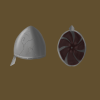Let's talk helmets
View attachment 78235
Above are eight somewhat major helmet variations throughout the centuries, from around 11th century until 16th century. The thing to note is that quite often these helmets have a lot of variation within them since they were all hand-made, and quite often the helmets could and would be simultaneously seen on the battlefield. For instance, although it's true that the English were a little slower to develop throughout history than the rest of the world when it came to warfare, it was still not uncommon for a wealthy man at arms to own both a Great Bascinet and an Armet. Numbers 1 and 2 would be seen together at times, as well as 5, 6 and 7. 7, in a slightly more advanced fashion, often with a slightly smaller beak, could be seen alongside 8 through 16th century, although this would be a rare occurrence.
1. A Nasal Helmet - these helmets were the bread and butter of warfare for centuries, although this particular variation, known quite often as a Norman helmet, would be most common in 11th and early 12th centuries. It can be differentiated from earlier nasal helmets by the rather tall height, giving room between the head and the steel to absorb some impact.
2. Great Helm 1 - For whatever reason, the development of helmets took a step back in mid to late 12th century with the introduction of the first, very basic great helm. The reason why I say it took a step back is that for one reason or another the tops of helmets became flat for well over a century. This gave a very nice surface for a blunt weapon to bite into and deliver a powerful impact directly to the skull. Despite this the first great helms were also some of the first helmets in the Medieval period to feature full facial protection. The rest of the head would be protected by a mail coif, which was a hood made out of mail.
3. Great Helm 2 - Before I go on I should note that Great Helms such as this but with flat top existed and were even very popular for a while, but I am certain you have the imagination to imagine the great helm with a flat top. If not, Google is your friend. Anyway, these great helms would be some of the first full head helmets to feature rounded surface at the top. On top of this, a knight in this period would often wear a skullcap worn either over or under his coif. This would offer a huge amount of protection. While these helmets were extremely robust and great from a purely defensive standpoint, they would be troublesome as breathing and sight were both important factors that these helmets did not account for. Still, this is an obvious beginning to the later sugarloaf helmet, and the skullcap would over time develop into the bascinet, which is the fourth helmet presented. This helmet would be popular throughout the 13th and early 14th centuries. It later developed into the frogmouth helmet which was popular in jousting.
4. The Bascinet - A lot can be said about the bascinet, as it is one of the more important helmets in history. As said previously, it is a development of the skullcap, which overtime became more conical at the top to offer a better glancing surface against blows. The bascinet would be the helmet worn by the men at arms of both sides at the battle of Agincourt, and was the staple of warfare through mid to late 14th century. While perhaps not as amazingly protective as the great helm, the bascinet offered a detachable visor which could be lifted to allow the user to breathe and see the battlefield when everything seemed safe. You have to understand that you can't live in a Medieval helmet. These things are stuffy and difficult to breathe in after the smallest amount of exertion. Throat protection was provided by a few layers of mail, with a mail aventail, affixed directly to the helmet, which would start just under the user's lips. An important helmet to mention is the Great Bascinet, which came in late 14th and early 15th centuries. It was a bascinet with a very robust steel protection for the throat. While not popular in mainland Europe, English knights who often fought on foot used it rather extensively.
5. The Sallet - The sallet is a very characteristic helmet of the mid 15th century. It's a very universal helmet, often seen with an adjustable beaver to protect the lower parts of the face, which allowed the user to attach both the helmet and the beaver to different degrees allowing greater vision or greater protection. While this helmet may look odd it's one of the most flexible helmets, with contemporary artwork of the time showing them being worn by both the knight class and the common soldier. There is a lot of evidence to suggest that archers wore these helmets, for instance.
6. Armet 1 - The armet can be seen developing more or less alongside the Sallet, though while the sallet grew in northern parts of Europe, the armet became popular in Italian school of armouring, quite famously the Milanese school. It was truly the first helmet which would encapsulate the user's head more closely, going as far as protecting the user's jaw and neck without any additional pieces. This was possible because the armet would open in its entirety, allowing the user to put their head into it, and then would lock on the back of the head via a screw.
I should note here that there is also a helmet called the close helm, which is almost the same as the armet. The difference between the two is that the armet has hinged cheek pieces which separate to allow the wearer to put his head in, while the close helm is separated in two around the same hinge that the visor is attached to, and opens vertically. There are images on Google to show the difference better than I explain it.
7. Armet 2 - Yet another armet from around mid 15th century. This particular example features a wrapper plate, which was a plate that attached to the visor to offer an additional layer of protection to the face and the throat, which was perfect for jousting and for fighting. The wrapper plate would be attached via leather straps, and when you see a large disc at the back of an armet helmet it's there to protect the straps from getting cut.
8. Burgonet - The armet developed into the burgonet as overtime protection became less desirable than vision and breathing. This should not, however, be seen as the success of firearms, but moreso the slow fading of the knightly class and the eventual decrease in the use of heavy cavalry in European warfare doctrines. This is a subject I could go on about for hours, but nah!
So which helmet would be the most contemporary for the server? Most definitely 5, 6 and 7, as well as variations of the great bascinet I discussed but have not shown. Other helmets that would be used would probably be barbutes, kettle helmets and all sorts of other things, but these would be worn by those who either didn't need as much protection or simply couldn't afford it.









